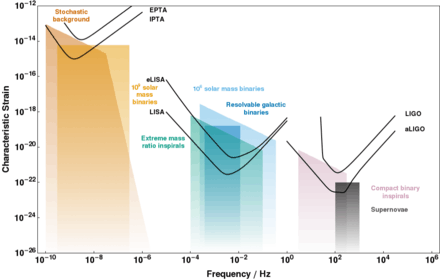Gravitational wave background
| Part of a series on | |||
| Physical cosmology | |||
|---|---|---|---|
 | |||
|
Early universe
|
|||
|
Components · Structure |
|||
| |||
The gravitational wave background (also GWB and stochastic background) is a possible target of gravitational wave detection experiments. The detection of such a background would have a profound impact on early-universe cosmology and on high-energy physics. The emission of gravitational waves from astrophysical sources can create a stochastic background of gravitational waves. For instance, a sufficiently massive star at the final stage of its evolution will collapse to form either a black hole or a neutron star – in the rapid collapse during the final moments of an explosive supernova event, which can lead to such formations, gravitational waves may theoretically be liberated.[1][2] Also, in rapidly rotating neutron stars there is a whole class of instabilities driven by the emission of gravitational waves.
Efforts to detect the gravitational wave background are ongoing. On 11 February 2016, the LIGO and Virgo collaborations announced the first direct detection and observation of gravitational waves, which took place in September 2015. In this case, two black holes had collided to produce detectable gravitational waves. This is the first step to discovery of the GWB.[3][4]
Detection of gravitational waves

On 11 February 2016, the LIGO/EGO collaboration announced the detection of gravitational waves, from a signal detected at 10:51 GMT on 14 September 2015[5] of two black holes with masses of 29 and 36 solar masses merging around 1.3 billion light years away. The mass of the new black hole obtained from merging the two was 62 solar masses. Energy equivalent to 3 solar masses was emitted as gravitational waves.[6] The signal was seen by both LIGO detectors, in Livingston and Hanford, with a time difference of 7 milliseconds due to the angle between the two detectors and the source. The signal came from the Southern Celestial Hemisphere, in the rough direction of (but much further away than) the Magellanic Clouds.[4] The confidence level of the discovery was 99.99994%.[6] The research made by the Rochester Institute of Technology contributed to the discovery.[7]
Future observations
Future gravitational waves observatories might see primordial gravitational waves, relics of the early universe, up to less than a second after the Big Bang.[8][9]
See also
References
- ↑ Ott, Christian D.; et al. (2012). "Core-Collapse Supernovae, Neutrinos, and Gravitational Waves". Nuclear Physics B: Proceedings Supplement. 235: 381. arXiv:1212.4250
 . Bibcode:2013NuPhS.235..381O. doi:10.1016/j.nuclphysbps.2013.04.036.
. Bibcode:2013NuPhS.235..381O. doi:10.1016/j.nuclphysbps.2013.04.036. - ↑ Fryer, Chris L.; New, Kimberly C. B. (2003). "Gravitational Waves from Gravitational Collapse". Living Reviews in Relativity. 6. doi:10.12942/lrr-2003-2.
- ↑ Abbott, B.P.; et al. (2016). "Observation of Gravitational Waves from a Binary Black Hole Merger". Phys. Rev. Lett. 116: 061102. arXiv:1602.03837
 . Bibcode:2016PhRvL.116f1102A. doi:10.1103/PhysRevLett.116.061102.
. Bibcode:2016PhRvL.116f1102A. doi:10.1103/PhysRevLett.116.061102. - 1 2 Castelvecchi, Davide; Witze, Alexandra (11 February 2016). "Einstein's gravitational waves found at last". Nature News. doi:10.1038/nature.2016.19361. Retrieved 11 February 2016.
- ↑ "Gravitational waves from black holes detected". BBC News. 11 February 2016.
- 1 2 LIGO’s First-Ever Detection of Gravitational Waves Opens a New Window on the Universe
- ↑ "LIGO Confirms RIT's Breakthrough Prediction of Gravitational Waves". Science Newsline – Space & Planetary. Rochester Institute of Technology. 11 February 2016.
- ↑ http://www.bbc.com/news/science-environment-35524440 Einstein's gravitational waves 'seen' from black holes
- ↑ http://www.scientificamerican.com/article/the-future-of-gravitational-wave-astronomy/ The Future of Gravitational Wave Astronomy

